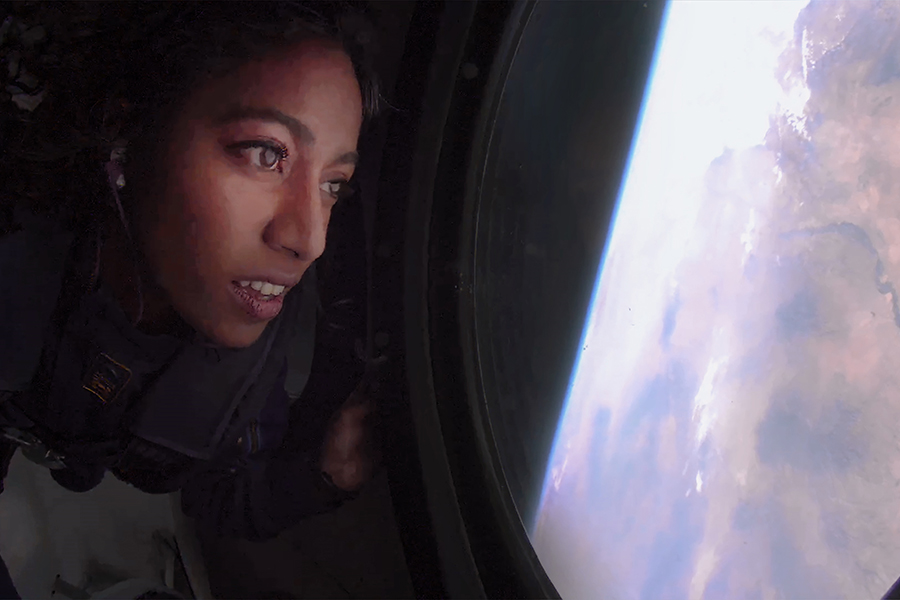Alumna Bandla becomes 26th member of Purdue's Cradle of Astronauts

Sirisha Bandla couldn’t quite articulate the experience.
She wanted something better than “incredible” to describe the suborbital flight to space on Virgin Galactic’s VSS Unity Sunday, but that’s ultimately what settled in her mind soon after realizing a dream she’d had since childhood.
And another she probably hadn’t quite articulated.
Bandla not only became a commercial astronaut with the flight, reaching 53.5 miles above the Earth, but she also officially was anointed into Purdue University’s Cradle of Astronauts.
Bandla, who earned her bachelor’s degree in 2011 in aeronautical and astronautical engineering, is the 26th member of the Cradle. She’s the 17th alum from the School of Aeronautics and Astronautics.
“I have wanted to be an astronaut, and I wasn’t able to go in the traditional NASA route,” Bandla told NBC News. “I took a very unconventional way to go to space. … I kind of wish I was still up there.
“The weightlessness is what we all talk about. Seeing the view of Earth is life-changing. But also the boost, the rocket motor kicking in. The whole trip to space and back has just been amazing.”
Bandla, the company’s vice president for government affairs and research operations, was one of four mission specialists on the flight, the first fully crewed for Virgin Galactic. Bandla’s role was to evaluate the researcher experience.

Bandla told Good Morning America she had the research experiment strapped to her leg. Bandla had three plant-filled tubes — a NASA-sponsored University of Florida experiment — and activated them at different stages of flight, allowing Virgin Galactic to test the ability of passengers performing science during flight.
It’s a unique capability, testing experiments for longer periods in microgravity than with aircraft or drop towers on Earth. Free floating in space can make it difficult to conduct certain tasks, she told Forbes, so she’ll provide recommendations on how to stabilize during microgravity.
Just as important: Savoring the moment, research needing to be done or not. Bandla said she’d work with future researchers to maximize the experience.
“I think it’s really important to actually look out the window,” Bandla told Forbes. “That was what got me at the end because I looked out the window, and I was mesmerized, and then I was like, ‘Oh, shoot, science.’”
While at Purdue in 2010, Bandla was selected to lead a student team that proposed a zero-gravity experiment to NASA. She led the design, build and test process with AAE Professor Steven Collicott in his AAE418 “Zero-Gravity Flight Experiment” course. The proposal was selected, and team flew with the experiment in NASA’s KC-135 aircraft in June 2011. The flight offered a short period of reduced gravity for testing.
That provided a glimpse of what she’d experience 10 years later.
With Sunday’s flight, Bandla is only the second commercial astronaut in the Cradle. The first, Beth Moses (BSAAE, MSAAE), also was on VSS Unity.
“Truly phenomenal the second time,” Moses said in the post-flight press conference.
Like Moses before her, Bandla made sure to honor her alma mater on her historic flight.
Tucked inside the inner pocket of Bandla’s spacesuit was a small pennant. When asked in the press conference after the flight what she took to space, Bandla shared the news and then followed with “Boiler up.” To which Moses chimed in, “Go Boilers.”
“Beth Moses, our chief astronaut instructor, prepared us so well,” Bandla told CNN of the flight, “that it’s not only training and operations and emergency procedures, it’s preparing for the experience. So I was sitting in the spaceship, I knew it was real. I knew exactly what to expect, so I could focus on the views and the experience, and it was just incredible.”
When Bandla walked onto the stage for the press conference, Virgin Galactic CEO Michael Colglazier said she had the “biggest smile in space.”
It likely won’t be going anywhere anytime soon.
Bandla received Virgin Galactic wings in a short ceremony after landing Sunday, but she likely will be receiving Commercial Astronaut Wings from the Federation Aviation Administration soon, too.
And there’s still congratulatory emails, texts, voicemails and messages on social media to reply to.
The response since Bandla was announced as part of the crew on July 1 has been overwhelming. Bandla is the third Indian-origin woman to fly in space, according to the U.S. Embassy in India, and Vice President Venkaiah Naidu even tweeted about her, saying her achievement will “motivate many more young girls in Indian & abroad to take up challenging careers.”
